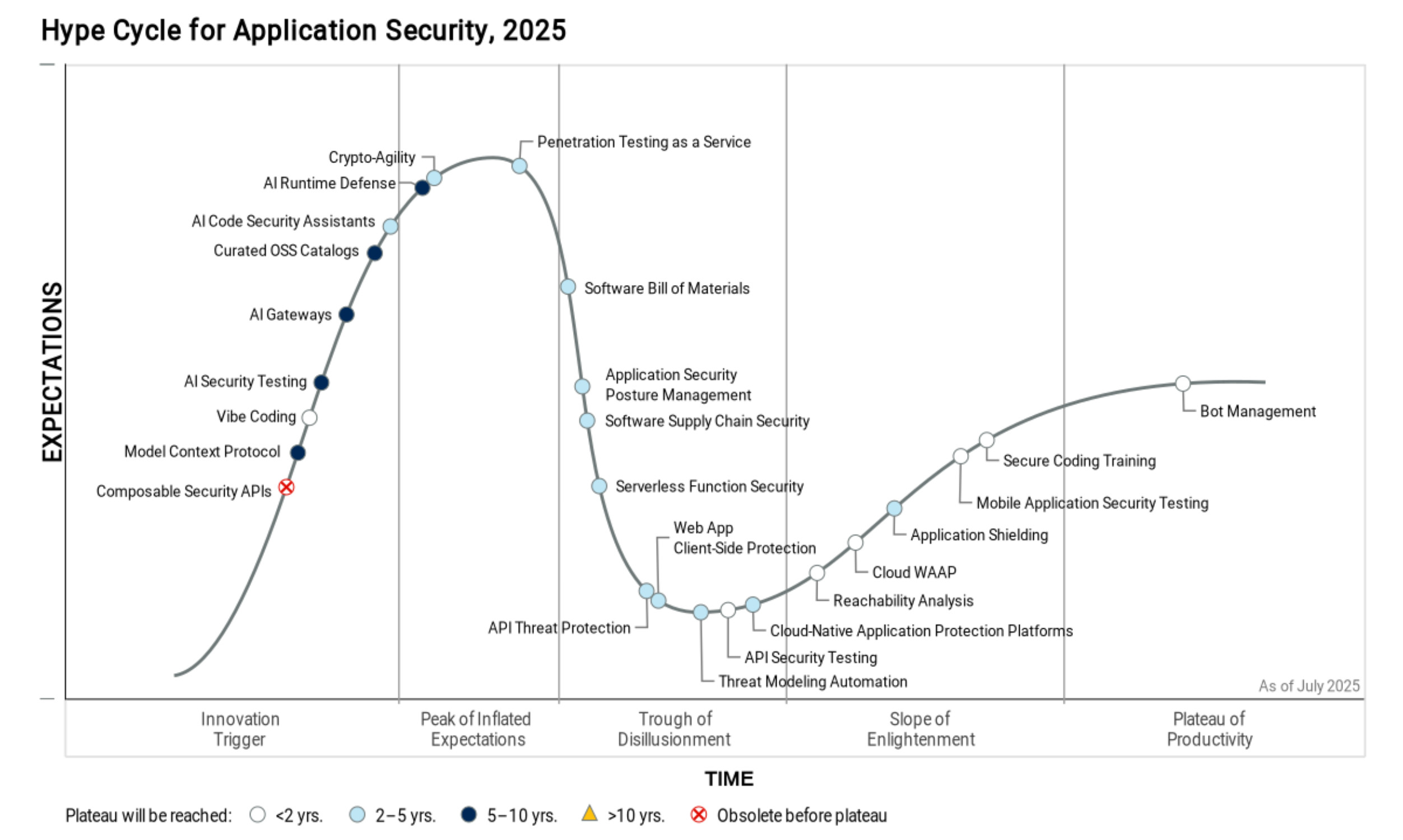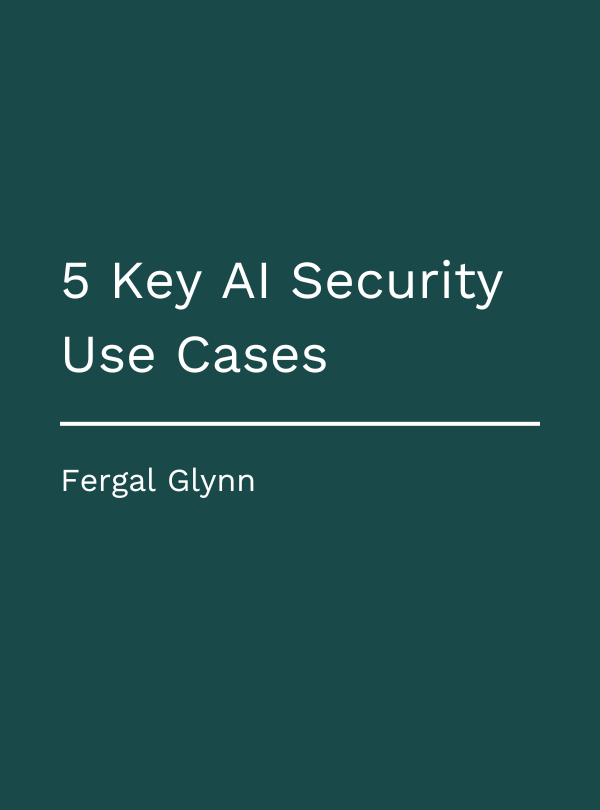What is the Gartner Hype Cycle for Application Security?
Gartner’s Hype Cycles track the maturity, adoption, and business impact of emerging technologies. For application security, the Hype Cycle provides CISOs, AppSec leaders, and developers with a structured way to evaluate which innovations are worth investing in today, which are overhyped, and which are approaching mainstream adoption.
Unlike the Gartner Market Guide, which defines a market and its players, or the Magic Quadrant, which evaluates leading vendors on execution and vision, the Hype Cycle charts technologies along five stages — from “Innovation Trigger” through to “Plateau of Productivity.”
For application security, the Hype Cycle highlights technologies that help protect applications, APIs, AI systems, cloud workloads, and supply chains. It captures both mature categories (like penetration testing and API protection) and emerging innovations (like AI security testing and vibe coding security).
What’s New in the 2025 Hype Cycle?
Several innovations appear or shift position in the 2025 Hype Cycle:
- AI Security Testing: New in 2025, AI security testing is recognized as an emerging category designed to uncover vulnerabilities in AI-enabled applications, including chatbots and agentic systems.
- AI Runtime Defense: Formerly labeled “AI security and anomaly detection,” this category matures and is now positioned at the Peak of Inflated Expectations. It focuses on real-time defenses against prompt injection, data leakage, and anomalous AI behavior.
- Vibe Coding: Coined by Andrej Karpathy, this early-stage innovation reflects AI-augmented coding environments where developers prototype software in “flow” states, but introduces new security risks.
- Consolidation of AppSec Tools: Gartner highlights increasing overlap between API testing, WAAP, CNAPPs, and software supply chain security, noting a shift toward platform consolidation.
- Quantum-readiness: Crypto-agility gains prominence as organizations prepare for quantum cryptography risks.
What Are the Key Findings of the Hype Cycle?
According to Gartner:
- AI reshapes AppSec: Generative AI is expanding the attack surface, requiring testing methodologies and defenses that legacy tools cannot provide.
- Shift-left continues: DevSecOps adoption drives organizations to equip developers with AI code security assistants and reachability analysis tools.
- Systemic risks grow: Supply chain attacks, SBOM requirements, and composable APIs introduce new exposures.
- AI runtime defense is critical: Protecting applications at runtime is now essential to prevent prompt injection, data leakage, and toxic outputs.
- Platformization accelerates: Security leaders are consolidating overlapping tools into unified AppSec platforms to reduce complexity.
- High-stakes regulation: Global policy frameworks mandate more structured approaches to AI application security testing and monitoring.
How Does the Hype Cycle Work?
The Hype Cycle follows five stages of technology adoption:
- Innovation Trigger – A breakthrough generates attention but limited adoption.
- Peak of Inflated Expectations – Hype drives investment and experimentation, but results are uneven.
- Trough of Disillusionment – Early failures cause skepticism and retrenchment.
- Slope of Enlightenment – Understanding improves, and real-world use cases drive adoption.
- Plateau of Productivity – The technology becomes mainstream, with proven ROI and vendor consolidation.
For AI security, Gartner places AI security testing at the Innovation Trigger, while AI runtime defense is at the Peak of Inflated Expectations, reflecting both excitement and the challenge of practical implementation.
Where Do AI Security and Red Teaming Fit?
AI Security Testing is recognized as an emerging innovation at the start of the Hype Cycle. Gartner defines it as testing that identifies vulnerabilities in AI-enabled systems through offensive tactics such as adversarial prompts, model scanning, and repository analysis.
This placement reflects the early but growing demand for AI security solutions. While adoption is nascent, enterprise stakeholders recognize that traditional SAST, DAST, and IAST do not test AI-specific risks like prompt injection, data leakage, or model inversion.
Red teaming for AI — the deliberate adversarial testing of AI systems — falls under this category, and Gartner explicitly lists Mindgard among the representative vendors.
Key Phases of the 2025 Hype Cycle
Innovation Trigger
Technologies: AI Security Testing, Model Context Protocol, Vibe Coding, Curated OSS Catalogs.
- These innovations are nascent but critical, especially for organizations deploying AI-driven applications.
- Adoption remains limited to early adopters and forward-looking security teams.
Peak of Inflated Expectations
Technologies: AI Runtime Defense, AI Gateways, Crypto-Agility.
- Vendors promise comprehensive defenses against AI attacks, but challenges include false positives, integration difficulties, and limited visibility into AI models.
Trough of Disillusionment
Technologies: Some legacy categories (e.g., RASP) that haven’t scaled well.
- Initial enthusiasm wanes as organizations discover limitations.
Slope of Enlightenment
Technologies: Secure Coding Training, ASPM, Reachability Analysis.
- Organizations find practical ways to integrate these into DevSecOps pipelines.
Plateau of Productivity
Technologies: Penetration Testing as a Service, CNAPPs, WAAP.
- Mature offerings with wide adoption and established ROI.
Mindgard’s Inclusion in the 2025 Hype Cycle
Mindgard is named as a representative vendor in the AI Security Testing category. Gartner highlights this category as a critical innovation for identifying vulnerabilities in AI-enabled applications and systems, from chatbots to goal-driven AI agents.
Mindgard’s platform is built specifically for offensive security testing of AI systems, enabling enterprises to:
- Conduct AI red teaming to uncover vulnerabilities beyond prompt-response evaluations.
- Test multi-step, agentic AI workflows in realistic environments.
- Integrate with CI/CD pipelines and security tooling, ensuring testing is embedded into DevSecOps.
- Provide actionable remediation insights that go beyond scoring model outputs, addressing vulnerabilities at the system level.
This recognition validates Mindgard’s role as a leader in AI security testing, bridging the gap between traditional application security and the unique risks of AI-driven applications.
Why AI Security is Central to the Application Security Landscape
AI is no longer a niche feature. Enterprises are embedding GenAI models, autonomous agents, and multimodal AI across customer-facing and internal applications. This creates new risks:
- Prompt Injection: Attackers manipulate model behavior by injecting malicious instructions.
- Data Exfiltration: Sensitive data can be leaked through AI outputs.
- Model Exploitation: Adversaries exploit weaknesses in probabilistic models.
- Infrastructure Risks: AI systems integrated with APIs, databases, and SaaS platforms introduce new attack chains.
Traditional AppSec tools — designed for code scanning and runtime application protection — cannot fully address these threats. AI security testing provides the missing capability, ensuring that AI systems are validated against real-world adversarial scenarios before deployment.
How Mindgard Aligns with Gartner’s Analysis
Mindgard’s capabilities align closely with the needs Gartner identifies in the 2025 Hype Cycle:
- AI Security Testing: Purpose-built offensive security testing for AI systems, from chatbots to multi-agent applications.
- Runtime Integration: Complements AI runtime defense by testing vulnerabilities before deployment and integrating into observability workflows.
- Supply Chain Awareness: Scans AI model repositories, libraries, and frameworks for vulnerabilities and misconfigurations.
- Developer Enablement: Integrates into DevSecOps pipelines, supporting the “shift-left” movement with repeatable, automated AI red teaming.
- Regulatory Alignment: Supports compliance with NIST AI RMF, EU AI Act, and other emerging frameworks by providing structured, auditable testing results.
By addressing these areas, Mindgard ensures enterprises can adopt AI confidently, with security integrated across the AI lifecycle.
Frequently Asked Questions
What is Gartner’s Hype Cycle?
A framework that tracks the maturity and adoption of emerging technologies across five phases, helping enterprises prioritize investments.
Where is AI Security Testing positioned in 2025?
At the Innovation Trigger stage, reflecting early adoption but high importance for securing AI-enabled applications.
Why was Mindgard included?
Mindgard is recognized for its AI red teaming and security testing platform, which uncovers vulnerabilities beyond the reach of traditional AppSec tools.
How should enterprises use this Hype Cycle?
As a strategic guide for planning application security investments — balancing mature solutions with emerging innovations like AI security testing that address newly critical risks.
How does this differ from the Market Guide or Magic Quadrant?
The Hype Cycle shows technology maturity and adoption, while the Market Guide defines a market and the Magic Quadrant evaluates leading vendors.
Conclusion
The 2025 Gartner Hype Cycle for Application Security reflects a rapidly shifting landscape. AI-enabled applications, composable architectures, and evolving threats demand new approaches.
Among the most significant developments is the recognition of AI security testing as an essential innovation. By naming Mindgard a representative vendor in this space, Gartner underscores the growing importance of offensive security testing for AI systems.
As enterprises prepare for regulatory scrutiny and real-world attacks, integrating AI security testing into the broader application security program is no longer optional. Mindgard provides the capabilities organizations need to move beyond surface-level evaluations and uncover the systemic vulnerabilities that attackers exploit.
Gartner clients can access the full report here.





